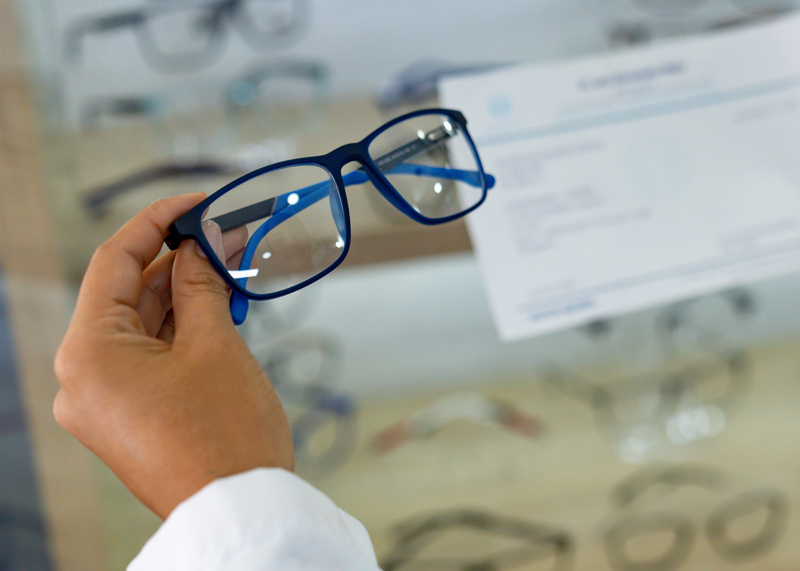Eyeglass Lenses

Exploring Eyeglass Lenses: Clarity, Comfort and Customization
Just as there are many different types of frames to choose from when it comes to picking out a pair of glasses, there are different types of lenses as well. From understanding different lens types, materials and customization options, knowing the basics when it comes to lenses will help you find your perfect fit.
Lens Prescriptions
Eyeglass lenses come in various types to correct different vision conditions and address specific needs.
Single Vision Lenses: Single vision lenses are designed to correct one type of vision problem, such as nearsightedness (myopia), farsightedness (hyperopia), or astigmatism. They provide consistent vision correction throughout the entire lens.
Bifocal Lenses: Bifocal lenses have two distinct optical powers: one for distance vision and another for near vision. They feature a visible line separating the two powers, allowing wearers to see clearly at both distances.
Progressive Lenses: Progressive lenses, also known as no-line bifocals or multifocal lenses, offer a seamless transition between different vision zones, including distance, intermediate, and near vision. They provide clear vision at all distances without the appearance of a visible line.

Types of Lens Materials
Eyeglass lenses are available in various materials, each with unique properties, such as impact resistance, lightweight feel, and thinness, to meet different vision correction needs and lifestyle preferences.
CR-39 Plastic Lenses: CR-39 lenses, also known as plastic lenses, are made from a lightweight, impact-resistant material called allyl diglycol carbonate. These lenses offer excellent optical clarity and are relatively affordable compared to other lens materials. They are ideal for individuals with mild to moderate vision corrections and those looking for budget-friendly options.
Polycarbonate Lenses: Polycarbonate lenses are highly impact-resistant and lightweight, making them an excellent choice for safety glasses, sports eyewear, and children’s eyeglasses. They provide superior durability and protection against impact, making them less likely to shatter or break upon impact. Polycarbonate lenses also offer built-in UV protection and are thinner and lighter than CR-39 lenses, making them more comfortable to wear, especially for individuals with higher prescriptions.
High-Index Lenses: High-index lenses are designed for individuals with higher prescriptions who desire thinner and lighter lenses. These lenses are made from materials with a higher refractive index than CR-39 or polycarbonate, allowing them to bend light more efficiently and reduce lens thickness. High-index lenses offer superior optical clarity and aesthetic appeal, as they can minimize the “bug-eye” effect associated with thick lenses in stronger prescriptions.
Trivex Lenses: Trivex lenses are similar to polycarbonate lenses in terms of impact resistance and lightweight properties but offer enhanced optical clarity and scratch resistance. These lenses are made from a unique material called Trivex, which provides excellent optical performance and durability. Trivex lenses are ideal for individuals with active lifestyles or those who require superior vision correction without compromising on comfort or safety.
Glass Lenses: While less commonly used today, glass lenses offer exceptional optical clarity and scratch resistance. However, they are heavier and more prone to shattering than plastic or polycarbonate lenses, making them less suitable for certain applications, such as sports eyewear or children’s glasses. Glass lenses are still preferred by some individuals for their unparalleled visual acuity and durability.
Styles and Customization Features
In addition to different lens types, eyeglass lenses offer various customization features to enhance comfort, clarity, and protection.
Anti-Reflective Coatings: Anti-reflective coatings reduce glare and reflections on the lens surfaces, improving visual clarity, reducing eye strain, and enhancing the appearance of your eyeglasses.
Photochromic Lenses: Photochromic lenses, also known as transition lenses, darken in response to UV light exposure and lighten indoors or at night. They provide convenient protection from sunlight and UV radiation while offering clear vision in various lighting conditions.
Blue Light Filtering: Blue light filtering lenses help reduce exposure to blue light emitted from digital screens, LED lights, and sunlight. They can help alleviate digital eye strain, improve sleep quality, and protect against potential long-term eye damage.
Lens Tints and Colors: Lens tints and colors can enhance visual comfort, reduce glare, and improve contrast for specific activities or environments. Options include polarized lenses for outdoor activities, tinted lenses for fashion or light sensitivity, and gradient lenses for driving.
How to Get Your Perfect Lenses
Getting the perfect pair of eyeglass lenses is a simple and straightforward process with the help of an optician or eyecare provider.
- Schedule an Eye Exam: Schedule a comprehensive eye exam with your eyecare provider to assess your vision and determine your prescription needs.
- Pick Your Lenses: Explore our wide selection of eyeglass lenses, including single vision, progressives, and specialty lenses, in various materials, coatings, and customization options.
- Complete a Lens Fitting: The optician will assist you in selecting lenses that meet your vision needs, lifestyle preferences, and budget. They can explain the different lens options and customization features available and help you choose the best lenses for your needs.
- Check Frame Compatibility: Your optician will ensure that your chosen lenses are compatible with your selected eyeglass frames and provide recommendations for lens thickness, weight, and style to achieve optimal comfort and aesthetics.
- Finalize Your Order: Once you’ve chosen your lenses, they will finalize your order and provide you with an estimated timeline for lens fabrication and assembly.
- Check Fitting and Make Adjustments: When your eyeglasses are ready, schedule a fitting appointment to ensure your lenses fit properly and provide clear, comfortable vision. Your eyecare provider can make any necessary adjustments to ensure optimal alignment and comfort.
